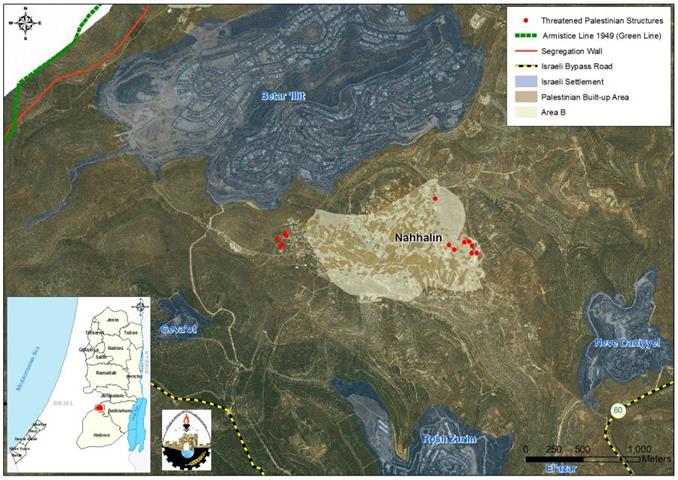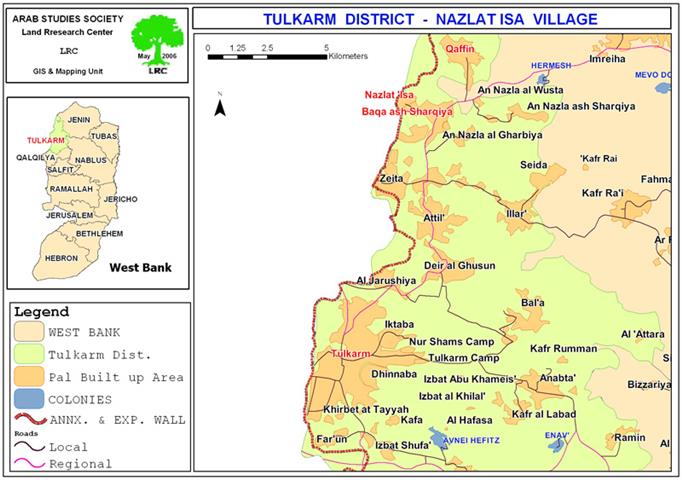On December 20, 2010, the Israeli Civil Administration (ICA) handed over local resident of al Kabbarat neighborhood in Nahhalin village southwest of Bethlehem city, five halt of construction orders for their houses and structures under the pretext of lacking building permits due to their location in area C, which falls under the full Israeli control according to Oslo II Interim Agreement. Residents of the neighborhood were given until the 16th of January 2011 to object the demolition order and apply for building permits for their threatened structures. It is worth mentioning that filing objections against the halt of construction orders at the ICA and applying to get building permits for their structures does not guarantee obtaining the permit required to build. Table 1 below:
|
Table 1: Threatened Palestinian Structures in Nahhalin Village Southwest of Bethlehem city – (December 12, 2010)
|
| No |
Owner Name |
Type of Structure |
Location |
No. of dwellers |
| 1 |
Bilal ‘Ali Ibrahim |
Blacksmith |
Al Kabbarat Neighborhood |
source of living |
| 2 |
Muhammad Abdel Majid
|
House |
Al Kabbarat Neighborhood |
8 members |
| 3 |
Wasfi Muhammad Theib |
Two storey house |
Al Kabbarat Neighborhood |
7 members |
| 4 |
Murad Lutfi Ibrahim Mussallam |
House |
Al Kabbarat Neighborhood |
Under construction |
| 5 |
Jamal Muhammad Theib Najajra |
House |
Al Kabbarat Neighborhood |
Under construction |
| Source: Nahhalin Village Council 2011 |
|
Source: ARIJ Field Team, 2011
|
In an interview conducted by ARIJ field team with Mr. Osama Shakarneh, head of Nahhalin village council, said that some of the owners have structures located in area B where Palestinians have full control over the civil responsibilities and the Israels have overriding responsibility for security issues according to Oslo II Interim agreement of 1995, and own building permits for their threatened structures. Map 1
Map 1: Location of threatened Structures in Nahhalin Village
Later on the 20th of January 2011, the Israeli Civil Administration again gave local residents of Al Kabbarat neighborhood in Nahhalin village halt of construction orders under the pretext of lacking building permits. Some of the threatened structures were given orders during the month of December 2010 under the same pretext. Table 2 gives details of the threatened structures in Al Bayyada neighborhood:
| Table 2: ThreatenedPalestinian Structures in Nahhalin Village Southwest of Bethlehem city – January 20, 2011 |
| No |
Owner of threatened Structure |
Type of Structure |
Location |
No. of family members |
| 1 |
Bilal ‘Ali Ibrahim
(A secondorder |
Black smith |
Al Kabbarat Neighborhood |
Source of living |
| 2 |
Muhammad Abdel Majid
(A second order) |
House |
Al Kabbarat Neighborhood
|
8 members |
| 3 |
Wasfi Muhammad Theib
(A secondorder) |
two storey House |
Al Kabbarat Neighborhood
|
7 members |
| 4 |
Nahhalin Village |
The village’s Mosque |
Al Kabbarat Neighborhood |
under construction house |
| 5 |
Adnan Ibrahim Yousif |
two storey house |
Al Kabbarat Neighborhood |
8 members |
| 6 |
Jameel Muhammad Theib |
a house and a garage |
Al Kabbarat Neighborhood
|
under construction house |
|
Source: Nahhalin Village Council 2011
|
| Source: ARIJ FieldTeam, 2011 |




It should be noted that the Israeli Civil Administration (ICA) gave on the 7th of June 2011, a number of halt of constuction orders to local residents in Al Bayyada neighborhood southwest of Bethlehem city under the same pretext. The ICA gave residents a period of three weeks to file objections against the military orders and apply to get a building permit for their structurs. Table 3 gives details of the threatened owners:-
| Table 3: Threatened Palestinian Structures inNahhalin Village Southwest of Bethlehem city – June 7, 2010 |
| No |
Owner Name |
Type of Structure |
Location |
No. of Family members |
| 1 |
Muhammad Abdel Rahman Sha’ban Shakarnah |
two storey house |
Al Bayyada Neighborhood
|
under construction house |
| 2 |
Ali Mustafa Abdel Qader Muhammad |
House |
Al Bayyada Neighborhood
|
9 members |
| 3 |
Raed ‘Ali Ghayatha |
House |
Al Bayyada Neighborhood
|
5 members |
| 4 |
Muhammad Isma’il ‘Ali |
Barracks |
Al Bayyada Neighborhood
|
— |
| 5 |
Ibrahim Daoud |
Barracks |
Al Bayyada Neighborhood
|
— |
| 6 |
Mahmoud Hasan Muhammad |
a wall |
Al Bayyada Neighborhood
|
— |
| Source: Nahhalin Village Council 2011Source: ARIJ Field Team, 2011 |
Nahhalin Village……Location & Population
Nahhalin village is located around 8 kilometers southwest of Bethlehem Governorate and houses a total population of 8053 (Palestinian Central Bureau of Statistics – PCBS, 2010). It is bordered by Husan village and the Illegal Israeli settlement of Betar ‘Illit from the north, the Illegal Israeli settlements of Rush Tzorim and Alon Shvut from the south, Geva’ot settlement from the west, and Neve Daniel settlement from the east. The village spreads over an area of 17250 dunums, of which, 496 dunums compromises the Palestinian built- up area (2.8% of the total village area).
According to the Oslo II Interim agreement of 1995, Nahhalin village lands, as well as the rest of the Palestinian Territory were divided into areas A, B and C. In Area A, the Palestinian National Authority has complete autonomy over administrative and security issues, where in area B, the Palestinians have civil responsibilities; while in Area C, Israel has full control over the security and administrative issues. Table 4 clarifies the classification of lands in Nahhalin village:-
| Table 4: Classification of Nahhalin Land According to Oslo II Interim Agreement of 1995 |
| %from the total Town lands |
Area-Dunums |
Land Classification |
| 0 |
0 |
Area A |
| 6.5 |
1,132 |
Area B |
| 93.5 |
16,118 |
Area C |
| 100 |
17,250 |
Total |
|
Source: Geographical Information System- ARIJ 2010
|
Nahhalin village and the Israeli Occupation
During the past decades, the Israeli Governorates managed to confiscate 3278 dunums of lands from Nahhalin village to establish one outpost, six Illegal Israeli settlements, and military bases on lands privately owned by villagers of Nahhalin. The Six Israeli settlements are among eleven Israeli settlements forming what the Israeli call ‘the Gush Etzion settlement bloc’, which was established after Israel occupied the Palestinian Territory in 1967. These settlements spread over 2988 dunums of lands. See Table 5 below:-
| Table 5: The Illegal Israeli Settlements built Nahhalin village Lands |
| Area-Dunums |
Population |
Date of Est. |
Settlement’s Name |
| 135 |
44 |
1984 |
Geva’ot |
| 688 |
29000 |
1985 |
Bitar ‘Illit |
| 889 |
364 |
1969 |
Rosh Zurim |
| 589 |
3300 |
1971 |
Allon Shvut |
| 583 |
422 |
1967 |
Kfar Etzion |
| 104 |
804 |
1989 |
Bat Ayin (Tzurif) |
| 2988 |
33934 |
***** |
Total |
| Source: ARIJ Database 2011 |
Nahhalin village and the Israeli Segregation plan
Nahhalin village along with the rest of western rural villages Husan, Battir, Wadi Fukin, and Al Jab’a are going to be entrapped in one big enclave where a population exceeding 21,000 Palestinian residents will be segregated between the Segregation Wall path and the 1949 Armistice Line (Green Line). These threatened Palestinian communities will be isolated with no geographical contiguity with other Palestinian areas in Bethlehem Governorate, particularly from the main urban center of Bethlehem city where private, public, and vital services such as hospitals, universities, schools, and organizations are located.
Conclusion
Israel continues to demolish the Palestinians houses in all over the Occcupied Territory under illegal justifications and pretexts to serve their end purpose, to uproot and to drive out as many Palestinians from their homes and lands to build more Illegal Israeli settlements, outposts, bypass roads, military bases. The Israeli demolition of the Palestinian houses constitutes a grave breach of the International law rules and conventions such as:
-
Article 49 of the Hague Conventions of 1907 states that ‘Individual or mass forcible transfers, as well as deportations of protected persons from occupied territory to the territory of the Occupying Power or to that of any other country, occupied or not, are prohibited, regardless of their motive.
-
Article 53 147 of the Fourth Geneva Convention of 1949 states that: ‘any destruction by the Occupying Power of real or personal property belonging individually or collectively to private persons, or to the State, or to other public authorities, or to social or cooperative organizations, is prohibited, except where such destruction is rendered absolutely necessary by military operations.’
-
The International Convention on the Elimination of All Forms of Racial Discrimination (1965) Article 5 provides that ‘States’ Parties undertake to prohibit and eliminate racial discrimination in all of its forms and to guarantee the right of everyone, without distinction as to race, color, or national or ethnic origin, to equality before the law, notably in the enjoyment of the following rights: … (e) in particular … (III) the right to housing’.



















